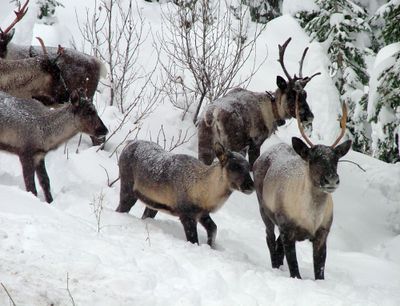Agency will study habitat of caribou
Conservationists hail decision as crucial for species’ survival

Just 45 woodland caribou are believed to remain in the Selkirk Mountains. This week, the U.S. Fish and Wildlife Service agreed to study whether their alpine habitat needs stronger protections.
Conservation groups, which petitioned the agency in 2002 for caribou critical habitat designations, hailed the decision.
“The Bush administration ignored this species and our petition for six years,” said Mike Leahy, Defenders of Wildlife’s Rocky Mountain region director. “This is one of the most endangered species in the country. We’ve pushed it all the way back into one mountain range.”
Caribou are relatives of deer. When deep snows force other animals out of the mountains, caribou head to elevations higher than 4,000 feet to eat lichen from old-growth forests. Their dinner-plate-size hooves act like snowshoes.
Once found from Washington to Maine, the Selkirk herd represents the last woodland caribou in the Lower 48 states. The herd roams between the Idaho Panhandle, southern British Columbia and northeast Washington, with the largest numbers of caribou north of the Canadian border.
Critical habitat designations typically follow Endangered Species listings. The Selkirk herd was federally protected under emergency order in 1983, but no habitat was designated because wildlife officials feared that poachers would use the maps.
Since then, caribou habitat has been posted with signs. The widespread signage is part of public education efforts to keep snowmobiles out of areas used by caribou, conservation groups said in their petition.
The U.S. Fish and Wildlife Service pledged to have a draft critical habitat decision ready by November 2011, with a possible designation by 2012.
“You can’t protect woodland caribou without protecting the places they live,” said Noah Greenwald, of the Center for Biological Diversity in Portland.
Logging, road-building and the popularity of snowmobiling have degraded caribou habitat, Greenwald said. Critical habitat designations ensure that federal activities don’t lead to habitat losses.
The Idaho Panhandle National Forests soon will release a draft winter travel plan for 400,000 acres in the Priest Lake area. The area has become a caribou conflict zone. Environmentalists say snowmobiles keep caribou from using habitat and creates packed trails for predators. Snowmobile enthusiasts dispute those claims.
The plan aims to protect caribou habitat while keeping snowmobilers’ dollars flowing into Priest Lake.
“As the mills have shut down, they’ve developed a recreation economy,” said Gail West, a Forest Service spokeswoman, “but we’re having to look out for the needs of caribou.”